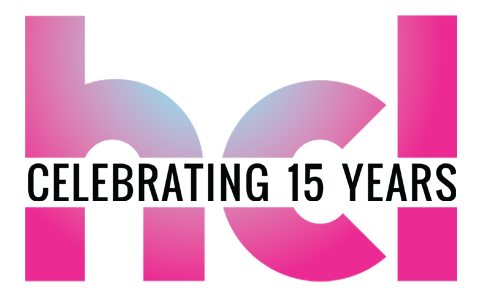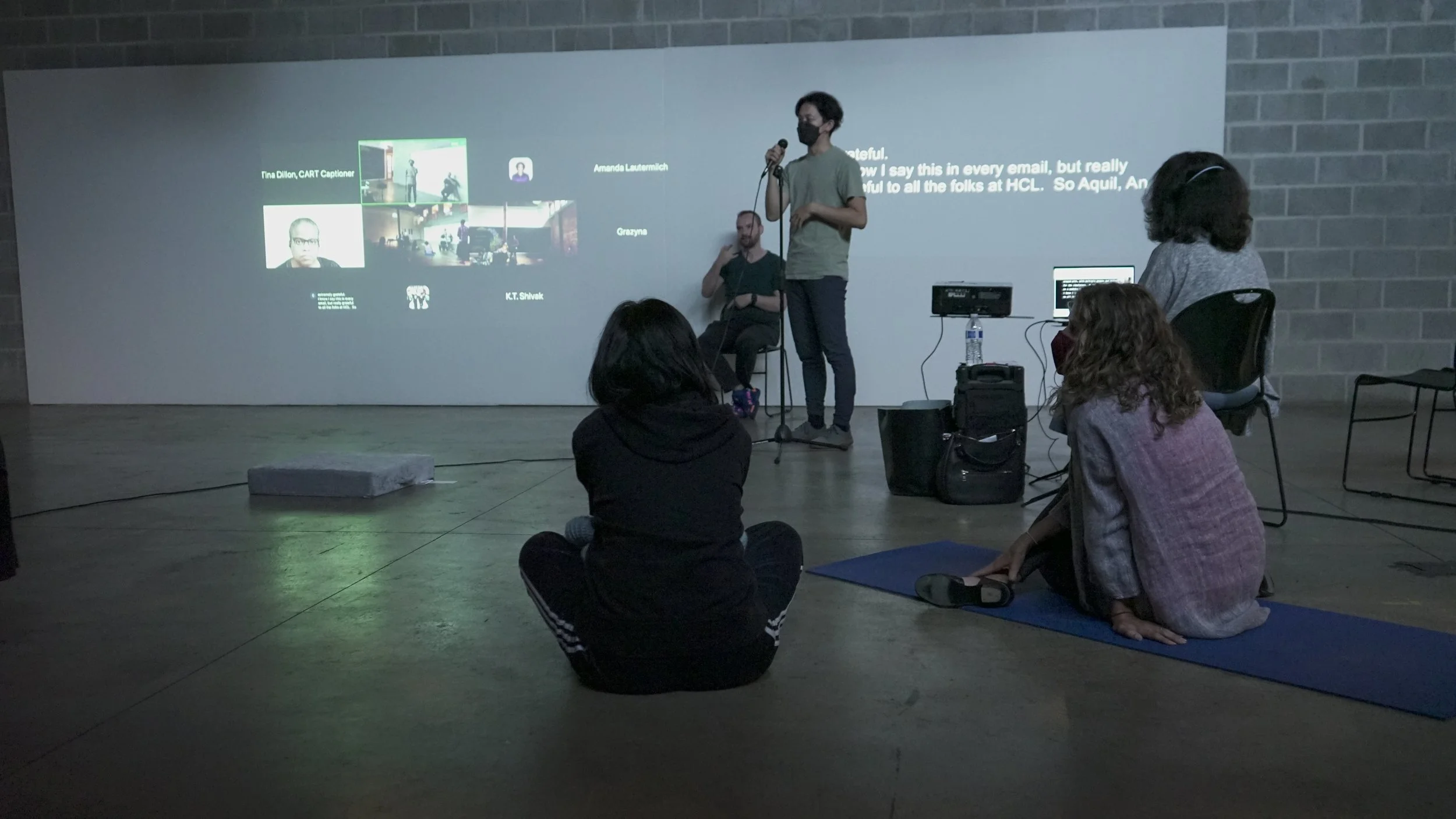Bradford Chin
he/they
Key Collaborators: Unfolding Disability Futures
Bradford, an Asian man, is pictured from the chest and up against an expansive, white background. He looks toward the camera with a quietly serious face, his lips closed in the middle of his black facial hair. His thick, wavy, coarse black hair is parted slightly off-center and rests about two inches above his ears, emphasized by a very short undercut. He wears a pale light blue, denim-looking button-down shirt with a banded collar that accentuates the verticality of his neck growing away from his slim shoulders.
In Bradford Chin’s words, “The power of collaboration expands the horizons of our storytelling. Every individual embodies a uniquely lived life, lending different perspectives to a shared experience or process.” This sentiment drives his work as an artist, activist, collaborator, and community member.
Bradford creates collaborative activist dance-based works that seek to shine light on the margins and envision the future. In seeking to center disability and propose new aesthetic paradigms, his work follows in the spirit of pioneers such as W.E.B. DuBois, Gloria Anzaldua, Judith Heumann, Patty Berne, and Ellice Patterson.
While traditional methods of performance and audience accessibility are often divorced from the creative process and positioned as a barrier to overcome, Bradford’s work centers disability and accessibility so that we may better understand how disability is conceptualized and positioned in dance and performance.
The Fellowship Project
Access in Motion: Movement dreams for the future (AIM) is a disability-centered, multimedia communal dance experience facilitated as a looping, interactive movement installation. Centering disability as a uniquely generative lived experience, this communal movement experience approaches accessibility media—including audio description, video projections, and considerations for accessible movement—as artistic tools. AIM challenges normative conceptions of how movement is generated and transmitted between participants and who has the ability and the right to dance.
In this vision for an accessible future, the disabled experience is centered as a source of hope, joy, and community: a model for how we can craft a future in which we return to ourselves and each other. In this vision for an accessible future, anyone can dance, and if anyone can dance our possibilities are infinite.
The Initial Project
With support from HCL, Bradford Chin continued exploring the use of Audio Description (“AD”) as the primary generative device in creating and presenting a dance work. This work involved the incorporation of text-based, non-body-specific movement descriptors into a combined, narrative audio description track that precedes, dictates, and develops alongside the movement generation process.
Bradford’s first year in residence with HCL laid the groundwork for the development of Access in Motion: Movement dreams for the future, which they will further develop during their fellowship year. With support from HCL, early-stage community-engaged workshops which took place in Chicago and Texas and visibilized and centered disability in dance in hopes that, through the communal movement experience, we might begin to better understand how we conceptualize disability and how it impacts the way we navigate our world.
David Bernal-Fuentes, Spencer Brown, Laura Cubanski, Taylor Grandy, Vanessa Hernández Cruz, Oriana Kou, Isabella Lara, Jessica Lopez Hernandez, Amanda Martz, and Beatrice White in The world was ending, so they danced, and they were free (2023), directed by Bradford Chin. Lighting design by Jimmy Balistreri; costume design by Kaylynn Sutton; set design by Bradford Chin.
Image Description: On a darkened stage, eight dancers bottleneck in a thin pathway of light that leads to a dim, fiery red portal blocked by a chain link fence. Six of the dancers grasp at each other in counterbalances while Vanessa collapses over her rollator walker with David slowly pacing around her. Outside the lit pathway, another dancer stands with her foot on the motionless body of a tenth dancer laying at her feet. All of the dancers wear shapeless brown coverings that obscure their bodies and their colorful, patterned tunics.
Caitlyn Cargnoni, Ashton Craven, Amanda Martz, Emma Mertens, Elizabeth Sah, Coral Scialpi, Alexa Wade, and Alicia Young in Sunrise: A case study in movement scores and Disability Justice (2022), directed by Bradford Chin. Lighting design by Jimmy Balistreri; costume design by Natalie Oga.
Image Description: Eight dancers are photographed in various states of arcing, jumping, traveling, swiping, and reaching in front of a bright, elegant purple-lit background. In a loose clump, their levels loosely range from highest level (jumping, most upright) on the left to lower level on the right. The eight women wear white-colored costumes of fitted tops and flowing bottoms along with white face masks.
Photo Credit: Skye Schmidt
About the Artist
Bradford Chin is a disabled dance artist & methodologist, DEIJ/Accessibility cultural strategist, and artistic audio describer. Their work pursues Disability Justice and collaboration toward investigating disability, ableism, and their impact on our artistry and world; centering disability as a richly generative lived experience that innovates our practices and expands our horizons; and better recognizing and honoring our collective humanity.
Based in Chicago and his native San Francisco and a recipient of the 2021-2022 California Arts Council Individual Artist Fellowship, their works have been described by LA Dance Chronicle as “conceptually fun.” Formerly a company member with AXIS Dance Company, he has performed works by choreographers including Arthur Pita, Jennifer Archibald, and Robin Dekkers, and has danced with the Los Angeles Philharmonic, Contempo Ballet, and Laurel Jenkins among others.
Specializing in dance & disability and Disability Justice-informed critically inclusive dance pedagogy, they have taught contemporary modern, ballet, and improvisation and/as composition techniques across the United States and internationally as an independent artist and for school and organizations including The Wooden Floor and Young Choreographers Project. For two years, he co-directed stART in partnership with ARTX (now Long Beach Museum of Art) and with funding by Arts Council for Long Beach. Formerly a research consultant for Dance Data Project, their research interests include disability in dance, critically inclusive dance pedagogy, and creative process/aesthetics in Western concert dance culture.
Bradford earned a BFA in Dance from California State University, Long Beach, where he later served as the inaugural Concert Accessibility Coordinator, and an MFA in Dance from the University of California, Irvine. His writing has been published by Dance Magazine and Stance on Dance, and his work has been supported by competitive funding from entities including the California Arts Council, The Actors Fund, and the UCI Center for Medical Humanities among others. He currently serves on the Advisory Council for the National Dance Education Organization.
For more information, visit BradfordChin.com
Events with HCL
Works in Progress Showcase
Wednesday, August 28, 2024
Art/Access Lab: Work in Progress Showing
Sunday, August 13, 2024





